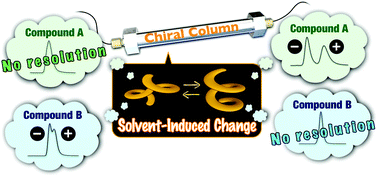Chiral stationary phases consisting of π-conjugated polymers bearing glucose-linked biphenyl units: reversible switching of resolution abilities based on a coil-to-helix transition†
Abstract
A series of optically active π-conjugated polymers (poly-2–poly-5) consisting of alternating thieno[3,4-b]thiophene and glucose-linked biphenyl units were synthesized through copolymerizations by Sonogashira–Hagihara cross-coupling. Absorption and circular dichroism spectroscopy and theoretical calculations revealed that poly-2 undergoes a conformational transition between the random-coil and helix in both solution and the solid state in response to the external solvent environment (chloroform and acetonitrile). Coated-type chiral stationary phases (CSPs) for high-performance liquid chromatography were prepared from both the random-coil and helical poly-2, and the influence of the polymer backbone structure on the chiral recognition ability was evaluated. The two CSPs showed somewhat complementary resolution abilities and the kinds of resolved racemates were dependent on the backbone conformation. In addition, an immobilized-type CSP with universal solvent durability was also prepared through copper-catalyzed click cyclization between an alkyne-appended poly-2 analogue and an azide-functionalized silica gel. The resulting CSP displayed repeatable switching of the chiral recognition ability based on a coil-to-helix transition of the polymer backbone by alternate column treatment with common organic solvents, such as chloroform and acetonitrile.



 Please wait while we load your content...
Please wait while we load your content...